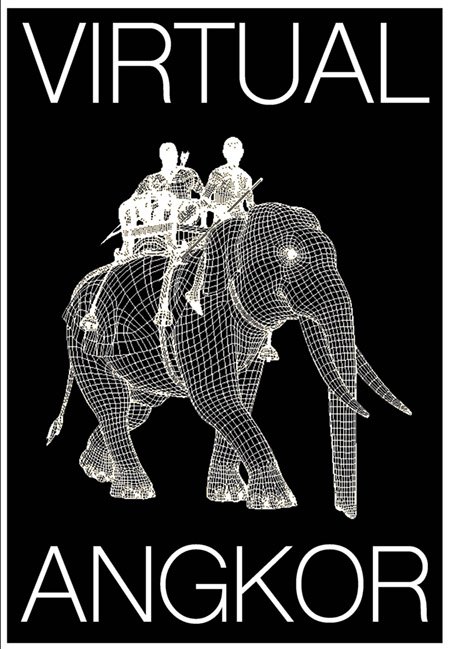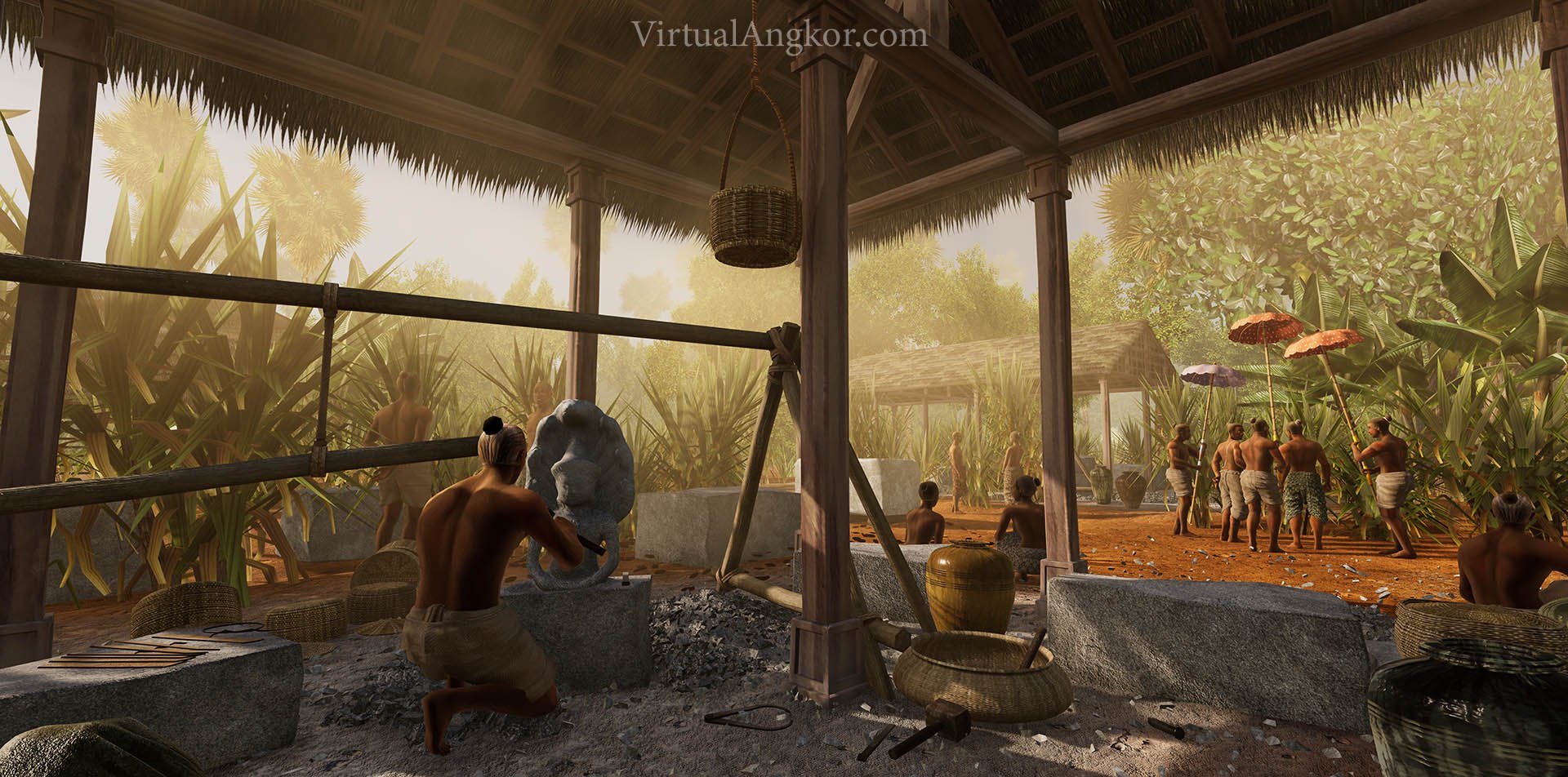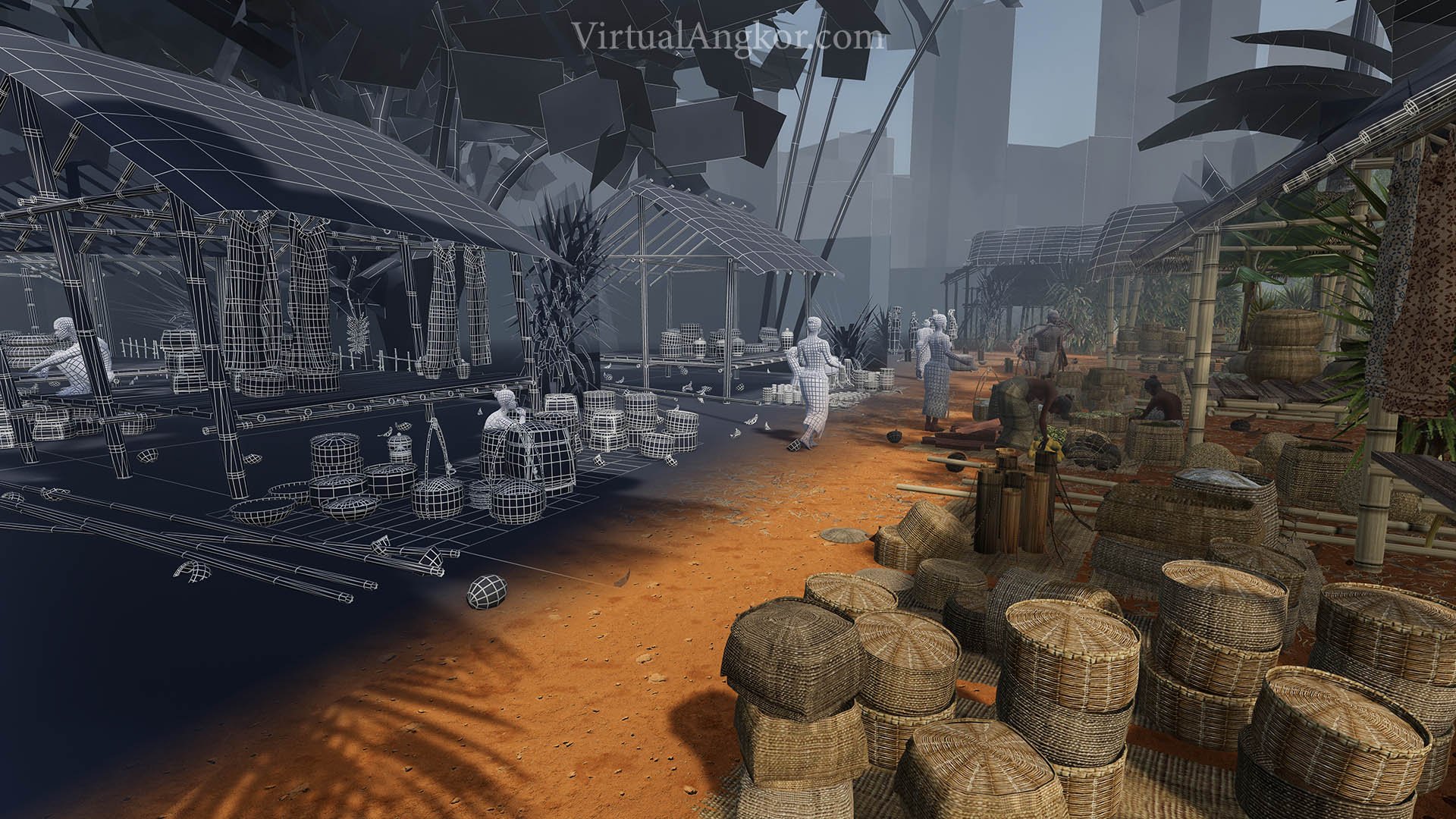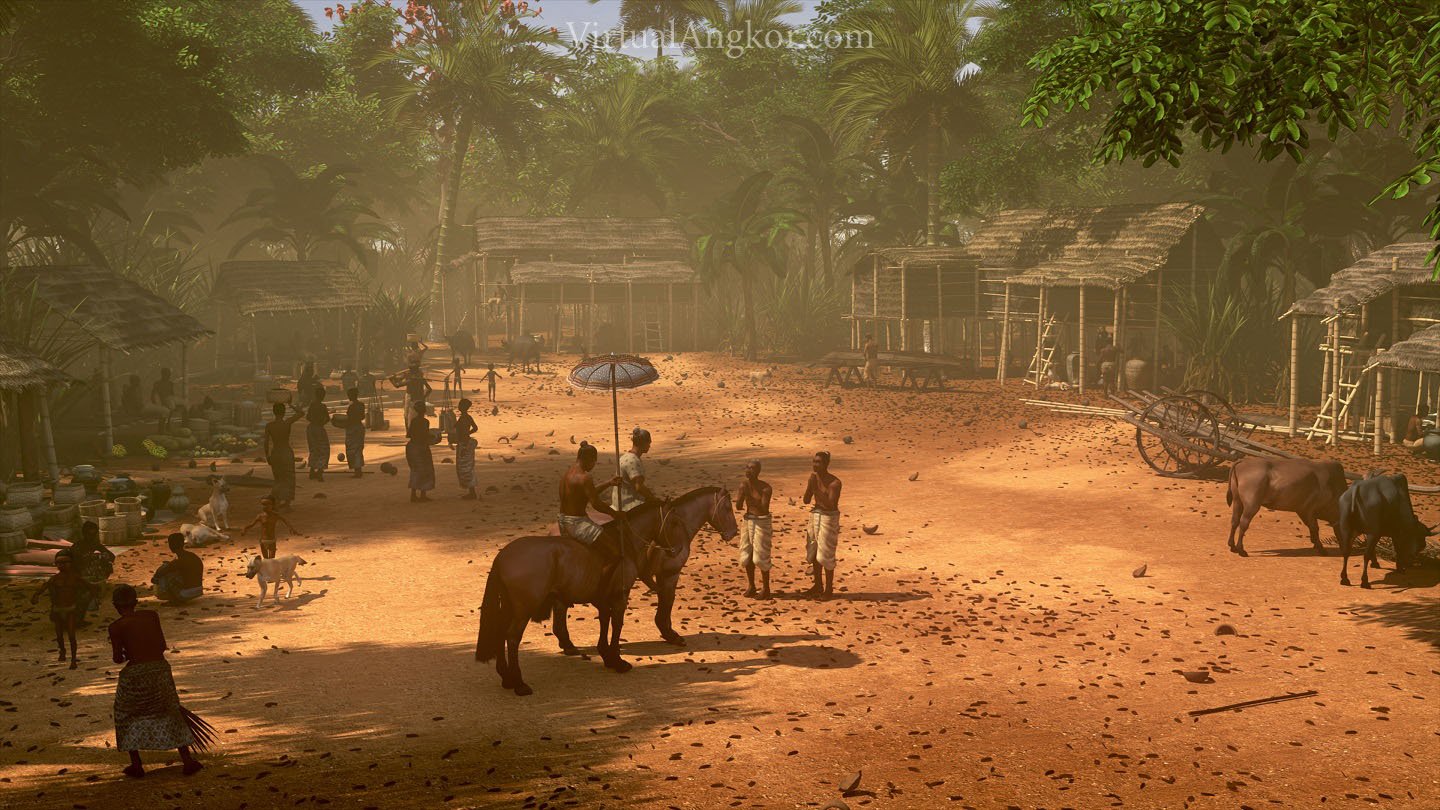Trade & Diplomacy
Angkor was enmeshed within well-established regional networks of trade and diplomacy that stretched across Asia. At the height of its power, the Khmer empire was part of an intricate network of international connections that extended to kingdoms in present-day Vietnam, Thailand, Indonesia and Malaysia as well as states further afield in India and China. In this module, we explore Cambodia’s broader place in the world through three themes.
Commerce and Trade
Thanks to its extensive water management system, Angkor was a highly efficient agrarian state that served as a rice bowl for wider Southeast Asia. Goods travelled through an interconnected system of overland, riverine and maritime routes that had Angkor as its centre.
Much of what we know about the Khmer Empire has been drawn from observations made by Zhou Daguan, a Chinese official dispatched to Angkor by the Temur Emperor. After he arrived, Zhou discovered groups of well-established Chinese merchants in Angkor. For Chinese traders in particular, the Khmer Empire was a lucrative destination where a range of products could be purchased. Explore the video below and read Zhou Daguan’s account of the Khmer economy.
“The local people who know how to trade are all women. So when a Chinese goes to this country, the first thing he must do is take in a woman, partly in a view to profiting from her trading abilities.
There is a market every day from around six in the morning until midday. There are no stalls, only a kind of tumbleweed mat laid out on the ground, each mat in its usual place. I gather there is also a rental fee to be paid to officials.
Small market transactions are paid for with rice or other grain and Chinese goods. The ones next up in size are paid for with cloth. Large transactions are done with gold and silver. In years gone by local people were completely naïve, and when they saw a Chinese they treated him with great respect and awe, addressing him as a Buddha and falling prostrate and kowtowing when they saw him. Lately, though, as more Chinese have gone there, there have been people who have cheated and slighted them.” (Daguan, 70–71)
Questions
What kind of products can you see in the marketplace? What does this tell you about the Khmer economy?
What was the Khmer Empire’s system of commerce? Did the Khmers have a form of currency?
Who, according to Zhou Daguan, is actually facilitating trade in the Khmer economy? What does this tell us about the nature of Khmer society?
Goods and Exchange
Aside from being an important source of natural products for China, Angkor also served as an important export market for Chinese manufactured goods, particularly ceramic and glass products. Surviving fragments of pottery and glass products found in Angkor have been crucial in demonstrating the involvement of Khmer elites in broader Southeast Asian maritime networks that connected the region to an international economic system dominated by trade.
“They do not produce gold or silver in Cambodia, I believe, and so they hold Chinese gold and silver in the highest regard.
Next they value items made of fine, double-threaded silk in various colors. Next after that they value such things as pewter ware from Zhenzhou, lacquer dished from Wenzhou, and celadon ware from Quanzhou and Chuzhou, as well as mercury, cinnabar, writing paper, sulphur, saltpetre, sandalwood, lovage, angelica, musk, hemp, yellow grasscloth, umbrellas, iron pots, copper dishes, glass balls, tung tree oil, fine-toothed combs, wooden combs, and needles – and of the ordinary heavier items, mats from Mingzhou. Beans and what are particularly sought after, but they cannot be taken there.” (Daguan, 71)
“The magnitude and variety of China’s ceramic trade are becoming increasingly clear through the meticulous work of archaeologists in China and Southeast Asia (summarised in Needham 2004). At Angkor, around 1300, Zhou Daguan had noted that the Chinese goods most in demand were ‘gold and silver, then light-mottled double-threaded silks. After these come tin goods from Zhenzhu, lacquered trays from Wenzhu, green porcelain from Quanzhou and Chuzhu’ (section 21, Smithies 2001: 63). Archaeology confirms the popularity of Chinese imports: during a quarter-century of fieldwork, from 1949 to 1974, Bernard Philippe Groslier, the last French Conservateur at Angkor, said he had excavated ‘literally thousands’ of Chinese sherds.” (Cremin 2007, 121)
“Although glass beads were found in large quantities in Southeast Asia during the Iron Age and into the first millennium CE, glass artifacts from the Angkorian period (ninth–fifteenth centuries CE) are less common and have not been as well-studied. This paper presents the results of an analysis of 81 glass beads and artifacts from the ninth-century royal capital of Hariharālaya and later (twelfth–fourteenth centuries CE) contexts from the walled city of Angkor Thom. Compositional analyses using laser ablation– inductively coupled plasma–mass spectrometry (LA-ICP-MS) have identified glass belonging to three broad compositional groups. The earlier Hariharālaya sites have numerous glass beads and vessel fragments made from vegetal soda glass, associated with Middle Eastern production, as well as high-alumina mineral soda glass of a sub-type frequently found at Iron Age sites in Southeast Asia and likely produced in South Asia. Beads from the later-period sites within Angkor Thom are primarily lead glass, associated with Chinese glass production, and different sub-types of high-alumina mineral soda glass that have also been found at sites in Southeast Asia dating from the fourteenth to the nineteenth centuries CE. A small number of beads from Angkor Thom also have a vegetal soda composition distinct from beads at Hariharālaya. The results of this study provide a new type of evidence for elite participation in broader regional exchange networks during the Angkorian period.”
(Carter et al. 2017, 1013)
Questions
What kind of Chinese goods did Khmer consumers want from Angkor? Why do you think they desired these items? What kind of significance do you think these goods had in Khmer society?
According to the articles, when did the relationship between Angkor and China begin to intensify? How have archaeologists come to this conclusion?
What evidence do Carter, Dussubieux, Polkinghorne and Pottier use to demonstrate that the Khmer Empire were part of a broader regional network of trade? What other polities were involved in this network?
Diplomatic Relation with China
China was the dominant diplomatic power in East and Southeast Asia for centuries. While the records are limited, we know that Cambodia operated within a wider international environment dominated by what is often called the Chinese tributary system, a network of diplomatic connections that bound the Chinese emperor and state to diverse polities across Asia. In the premodern period, a strong relationship with China was an important calculus in the foreign policy of Southeast Asian states as China’s status as the center of power in the region could be leveraged to gain political or economic advantage over competing kingdoms.
“The great Mandate of Heaven that the sacred dynasty has received includes everywhere within the four seas. Marshal Sodu set up a province in Champa, and sent out a general and a senior commander, who went there together. In the end they were seized and did not return. In the sixth month of the year youwei in the Yuanzhen reign period (1295), the sacred Son of Heaven dispatched an envoy with an imperial edict, and ordered me to accompany him.
In the second month of the following year, the year bingshen in the Yuanzhen reign period (1296), we left Mingzhou, and on the twentieth day of that month we set sail from the harbor at Wenzhou. On the fifteenth day of the third month we reached Champa, having been set back by adverse winds mid-journey. We arrived in Cambodia in the autumn, at the beginning of the seventh month.
We duly secured the submission of local officials.” (Daguan 45–46)
Hong-wu: Year 4, Month 11, Day 7 (14 December 1371):
"The minister Nai Yi-ji-lang and others who had been sent by Hu-er-na, the Ba-shan prince/king (巴山王) of the country of Cambodia, presented a memorial and offered local products as tribute in felicitation on the coming New Year's Day. The calendar Da Tong Li as well as patterned fine silks interwoven with gold thread were conferred upon the prince/king. The envoys who came were all presented with silk gauzes and patterned fine silks, as appropriate."
Hong-wu: Year 16, Month 4, Day 22 (24 May 1383):
"Envoys were sent to confer tally-slip books (勘合文冊) on the various countries of Siam, Champa and Cambodia. These were sent in order that when Chinese envoys arrived at these countries in future, the country could verify their status by fitting their tally-slip together with that of the envoy. If the tallies did not match, the envoy would be spurious and they were then to arrest him and inform."
Hong-wu: Year 21, Month 9, Day 15 (15 October 1388):
"The minister Nai Mao-li and others, who had been sent by the country of Cambodia, offered tribute of 28 elephants, 34 elephant handlers and 45 fan slaves to express gratitude for Imperial kindness in conferring a seal. It was Imperially commanded that clothing and paper money, as appropriate, be conferred upon the envoy and the officials."
Yong-le: Year 3, Month 7, Day 18 (12 August 1405):
"The Usher Wang Zi was sent to offer sacrifices for Can-lie Po Pi-ya, the deceased king of Cambodia. It was also ordered that the Supervising Censor Bi Jin and the eunuch official Wang Cong take an Imperial proclamation enfeoffing Can-lie Zhao Ping-ya, the eldest son of the deceased king of the country of Cambodia, as king of the country of Cambodia, and to confer paper money, silks and other goods upon him. They were also to escort the envoy Nai Mei home."
Yong-le: Year 12, Month 3, Day 11 (1 April 1414):
"The Chief Steward Zhu Yuan and others were sent as envoys to the country of Cambodia. Previously, the persons sent by Cambodia to offer tribute had said that their country had been repeatedly attacked by Champa. The envoys then long remained in the capital. At this time, the Emperor sent Yuan and others to escort the envoys home and to confer variegated silks upon Can-lie Zhao Ping-ya, the king of the country of Cambodia. Separate orders of warning were sent to Zhan-ba Di-lai, the king of the country of Champa, advising that he should concern himself with his own affairs and act in accordance with principles, while paying attention to the protection of his own territory and the maintenance of friendly relations with his neighbours."
Questions
Consider the language used in Zhou Daguan’s writing and in the excerpts from the annals of the Ming Dynasty. How did the imperial court conceive of China’s position in the international community of states?
What kinds of tribute did Cambodia send to China? How did the Chinese respond to these tributes?
Think about the tally-slip books mentioned in the entry from Hongwu Year 16, Month 4, Day 22. Why do you think the Chinese imperial court wanted to keep such detailed records? What does this suggest about the tributary system?
What do you think is the significance of the conferral of a calendar by the imperial court onto the Cambodian king?
What benefits did being part of the Chinese tributary system confer on smaller states like Cambodia?
Trade and Diplomacy Image Gallery
Further Reading
Carter, Alison, Laure Dussubieux, Martin Polkinghorne and Christophe Pottier, “Glass Artifacts at Angkor: Evidence for Exchange.” Archaeological and Anthropological Sciences (2017): 1-15.
Cremin, Aedeen. “Chinese Ceramics at Angkor.” Bulletin of the Indo-Pacific Prehistory Association 26 (2007): 121-123.
Daguan, Zhou. “General Preface.” In A Record of Cambodia: The Land and Its People, 45-46. Translated by Peter Harris. Chiang Mai: Silkworm Books, 2007.
Daguan, Zhou. ”Trade.” In A Record of Cambodia: The Land and Its People, 70-71. Translated by Peter Harris. Chiang Mai: Silkworm Books, 2007.
Daguan, Zhou. “Sought-After Chinese Goods.” In A Record of Cambodia: The Land and Its People, 71. Translated by Peter Harris. Chiang Mai: Silkworm Books, 2007.
Hong-wu: Year 4, Month 11, Day 7 (14 December 1371). Translated by Geoff Wade. Southeast Asia in the Ming Shi-lu: an open access resource, Singapore: Asia Research Institute and the Singapore E-Press, National University of Singapore.
Hong-wu: Year 16, Month 4, Day 22 (24 May 1383). Translated by Geoff Wade. Southeast Asia in the Ming Shi-lu: an open access resource, Singapore: Asia Research Institute and the Singapore E-Press, National University of Singapore.
Hong-wu: Year 21, Month 9, Day 15 (15 October 1388). Translated by Geoff Wade. Southeast Asia in the Ming Shi-lu: an open access resource, Singapore: Asia Research Institute and the Singapore E-Press, National University of Singapore.
Yong-le: Year 3, Month 7, Day 18 (12 August 1405). Translated by Geoff Wade. Southeast Asia in the Ming Shi-lu: an open access resource, Singapore: Asia Research Institute and the Singapore E-Press, National University of Singapore.
Yong-le: Year 12, Month 3, Day 11 (1 April 1414). Translated by Geoff Wade. Southeast Asia in the Ming Shi-lu: an open access resource, Singapore: Asia Research Institute and the Singapore E-Press, National University of Singapore.





